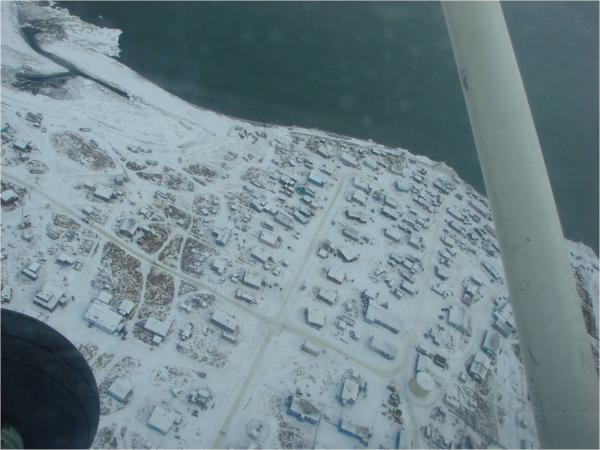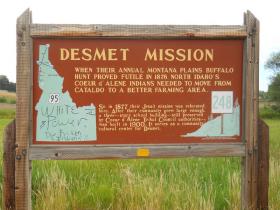Video: National Climate Assessment Focuses on Natives Bearing the Brunt
As the effects of climate change become more and more pronounced and better understood, the concerns of Indigenous Peoples are coming more and more to the fore. Conventional science is beginning to understand not only that they suffer inordinately from the phenomenon, but also that their traditional knowledge could hold some keys for adaptation, if not mitigation.
The National Oceanic and Atmospheric Administration’s Climate Change Assessment in May highlighted the effects on Indigenous Peoples, including those from the Pacific Islands and the Caribbean. In concert with that the authors made a video that lays out some of these challenges and how they are interconnected. Below, an interview with T.M. Bull Bennett, a convening lead author on the National Climate Assessment’s Indigenous Peoples chapter.
RELATED: Obama’s Climate Change Report Lays Out Dire Scenario, Highlights Effects on Natives
“We’re starting to see a change in how we interpret the environment around us,” Bennett says below. Indigenous populations, he adds, are “on the short end of the stick.”
Ballot Power: The Revolution in How Alaska Natives Vote
A perfectly timed combination of negotiation and grassroots organizing has allowed numerous Native villages across Alaska to become absentee in-person voting locations for federal elections for the first time. That’s a sea change from just a few weeks ago, when voters in only about 30 Native villages had a way to cast a ballot ahead of Election Day, said Nicole Borromeo, general counsel of the Alaska Federation of Natives (AFN). Meanwhile, Alaska’s urban voters had 15 days to do so. The locations will be in place for the August primary.
This transformation in voting access follows years of fruitless requests to the state for the election services by three groups: AFN, an organization of regional and village corporations, tribes and other entities; ANCSA Regional Association, a group of Native-corporation CEOs; and Get Out The Native Vote. “In late June, AFN and ANCSA sat down with the state and said, ‘we will sign up the locations,’” recalled Borromeo, who is Athabascan from McGrath Native Village. The state agreed, and the Native team began seeking groups and individuals to handle the election activities.
“Eleven days later, we had added 128 locations,” said Borromeo. “We have been entirely focused on this.” The goal is to bring equal voting rights to all of Alaska’s 200-plus indigenous villages, she said.
This has been a Native-led project, according to Borromeo: “We identified the problem, we identified the solution, and we made it happen. Now, the state has to play its part and do election training. We’ll be monitoring to be sure it happens. We intend to be a long-term partner in this effort.”
The project’s success shows that voting rights can be provided quickly and efficiently when there’s a will to do it, said Natalie Landreth, member of the Chickasaw Nation of Oklahoma and a Native American Rights Fund plaintiffs’ attorney litigating the Alaska Native voting-rights case Toyukuk v. Treadwell.
Media coverage of the just-concluded trial helped the Native team convince the state to let it set up the new voting centers, said Borromeo: “It was the perfect political storm.”

“Our people have a hunger to vote,” she added. “They go to huge lengths to do so, and overcome barriers no one else in the country faces.” Just to get to the polls, Alaska Native voters cope with fierce winter weather, vast distances and, in one village photographed by James Tucker, another Toyukuk v. Treadwell plaintiffs’ attorney, a raging river that separates two precincts sharing one ballot box. Pollworkers in a small launch brave ice-filled water to transport the box across the water, Tucker said.
The pressure of survival in a demanding environment is another hurdle. “During the election season, many rural voters are busy with subsistence activities and may not be near their polling place on Election Day,” said Jason Metrokin, ANCSA chair. The new centers expand their options and give them the same access as urban Alaskans, Metrokin said.
Once Alaska Native voters get to the polls, the traditional-language speakers need translation of election materials. However, testimony in Toyukuk v. Treadwell exposed yet another obstacle: longstanding systemic problems in the state’s delivery of federally mandated language assistance. (The judge’s decision is expected shortly.)
Lieutenant Governor Mark Treadwell, the lawsuit’s lead defendant, recently announced that the new locations will make 2014 election ballots “the most widely available in state history.”
That has the potential to transform politics in a state where indigenous people make up a fifth of the population. Said AFN president, Julie Kitka, “Having access to early voting is only the first step. Now our people need to learn about this right and understand what they’re being asked to vote on. There is much more work to be done by the state’s Division of Elections.”
Read more at http://indiancountrytodaymedianetwork.com/2014/07/15/ballot-power-revolution-how-alaska-natives-vote-155838
What’s Killing Clams? Solve This Low Tide Mystery
By Joshua McNichols, KUOW
One of the lowest tides of the year this weekend revealed a “crime scene” at the beach at Golden Gardens Park in Seattle.
The victims: thousands of clams that died in the prime of their lives. Each bivalve victim has a tiny hole drilled near its hinge.
Also strewn on the beach were gray rubbery things that looked like toilet plunger heads. The Beach Naturalists from the Seattle Aquarium say concerned citizens have collected them in buckets, upset that someone would have dumped so much litter on the beaches.
But it turns out that the holes and the toilet plunger heads are all the products of a little-known predator: the moon snail.
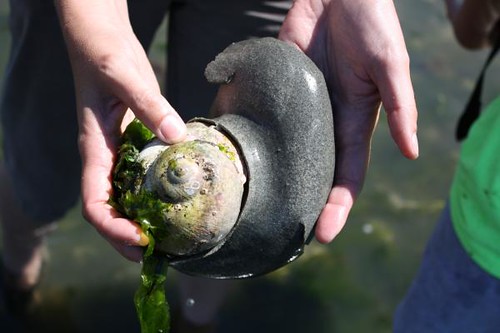
The culprit: Not a toilet plunger head, but the predatory moon snail. Credit KUOW Photo/Joshua McNichols
A Gruesome Murder
When it comes to the moon snail, Seattle Aquarium Beach Naturalist Will Downs is unwavering when he describes how the moon snail treats its victims: The snail “doesn’t see his prey. He feels them. He tastes them. And if you’re a clam, he sneaks up on you and engulfs you.”
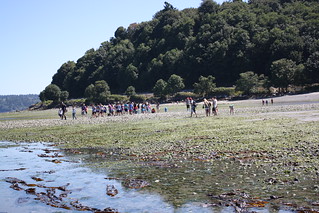
Low tide at Seattle’sGolden Gardens Park.
Credit: Joshua McNichols/KUOW
It gets worse. If the snail can’t smother the clam then and there, it drills through the clam shell with its bony, barbed tongue. That specialized tongue slowly files away at the clam, “day after day sometimes, until it can reach the interior, where the clam thought it was safe. Then it extrudes in there acids, enzymes, anything that’ll digest the clam.”
Downs grins as he delivers his punch line: “…and then it slurps up its own clam chowder.”
And those rubbery things that look like toilet plunger heads? Downs says they’re moon snail egg collars. The snail squeezes out the leathery substance by fusing together eggs, sand and its own mucus. As the egg collar emerges, it wraps around the moon snail’s shell, taking on the shell’s shape.
Case Closed
Before we condemn the moon snail, Seattle Aquarium naturalist Darcie Larson said the moon snail may be vicious predators of clams, but they’re an important part of the beach ecosystem of Puget Sound.
“If we had no predators, we might have too many shellfish. And then the shellfish population would get out of balance,” she said. “And they would eat up all the food, all the plankton in the ecosystem. We refer to predators like that as keystone species, and they hold the whole system together.”
So are moon snails threatened? Larson said anecdotally, the moon snails are doing well. Which is good, as other predators, such as sunflower sea stars, are currently suffering from a mysterious wasting disease.
This was first reported for KUOW.
Haida Master Carver and Students Restoring Ocean-Going Canoe
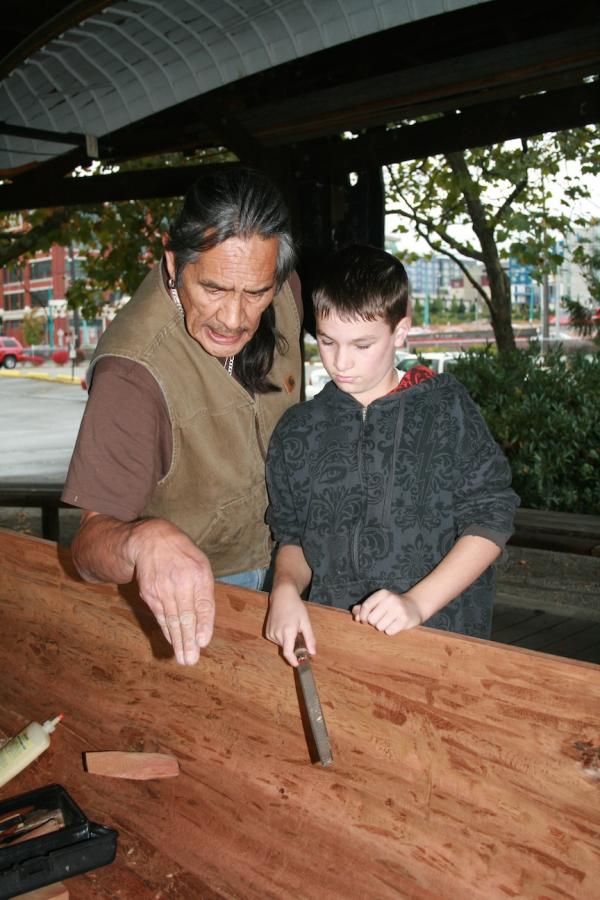
Saaduuts Peele, a Haida master carver, instructs Gabriel Port, a Samish Nation descendant, on a finer point of canoe carving on October 23, 2010, at the Center for Wooden Boats in Lake Union, Seattle. Saaduuts is resident carver at the center, and has carved two canoes with the assistance of local students.
Haida master carver Saaduuts Peele was a guest at Pinehurst K-8 School in Seattle, Washington on June 18 for the school’s final graduation ceremony—the school will soon be torn down to make way for a new school.
Peele and Pinehurst students carved a 40-foot ocean-going canoe, Ocean Spirit, in 2003-04 and gifted the canoe to the Native community of Hydaburg, Alaska in a potlatch in April 2004. The canoe was returned to Seattle on June 18.
Saaduuts, resident carver at the Center for Wooden Boats in Seattle, is doing some repairs to the canoe at the center. Once repairs are completed, the canoe will return to Hydaburg.
Read more at http://indiancountrytodaymedianetwork.com/2014/07/14/haida-master-carver-and-students-restoring-ocean-going-canoe-155826
Saving the sea that feeds us
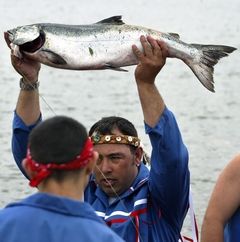
Tulalip tribal member Tony Hatch presents the first salmon of the fishing season during a Salmon Ceremony on the Tulalip Reservation in 2004. The traditional ceremony honors the first salmon to be caught with the hope that the fishing season will be plentiful. Following a feast, the bones of the salmon are returned to the water so that the honored fish will speak highly of the tribe.
By Les Parks, Source: The Herald
Puget Sound is one of the iconic wonders of the world and defines who we are, not only as tribes, but all residents of Western Washington.
This great body of water was still being formed by receding glaciers when the tribes arrived, and we have lived off her abundant natural resources ever since. Over thousands of years our beautiful and unique inland sea has become a complex ecosystem, supporting not only an abundance of sea life, but also mixing with freshwater resources at the mouths of our great rivers, providing a consistent and plentiful food source for us humans.
This natural resource wealth has influenced every part of our tribal traditions. Stories of the great salmon runs have been carried down through the generations, and they tell us these waters once rippled with silver, as salmon arrived home after several years out to sea. The clams, crab and mussels were also abundant, and along with berries, roots and the plants we harvested, our traditional diet was, and continues to be, sacred to us.
The old Indians used to say, “When the tide is out, the table is set!”
For more than 200 years the descendants of the settlers, and now peoples from around the globe, have called the Puget Sound home. Like the tribes, they have lived off her rich resources, appreciated her great beauty and passed laws to protect her from exploitation.
Today, however, the health of Puget Sound is failing fast. In recent years it has lost 20 percent, or more, of the plankton that makes up the base of our food web. Everything above plankton in the food chain is also affected and is showing signs of great stress. The loss of plankton is beyond comprehension and is the single greatest barometer of what is happening to the waters we have all largely taken for granted.
It is time the citizens of Washington, and in particular citizens of Puget Sound, act on this information. With plankton gone, it means every animal up the food chain pays the price, including us.
Mark my words: Puget Sound is dying! Finding whales dying from natural causes is expected. Finding whales that are emaciated and starving is alarming and will become a common scenario if we do not address the problem quickly. But what is happening; why are plankton dying? We are only beginning to understand the complex interactions between warming ocean waters, how they affect the state’s inland sea, and how human activities play into this alarming situation.
Toxins in the food chain are devastating from the bottom all the way up. Recent evidence suggests that nutrient pollution, such as nitrogen and phosphorus from wastewater treatment plants, septic systems, residential homes, agriculture and other sources, are significantly disrupting the food web in Puget Sound. We cannot continue to ignore the fact that the sound is the baseline of our livelihoods and that we humans are only as healthy as our environment.
The great waters and rivers of the Salish Sea have existed since the last ice age (13,000 years ago) and with the melting of the ice the Puget Sound was born. Mother Nature has created this beautiful place we call home, and in less than 200 years, and largely within the last 100 years, we have managed to undo what Mother Nature provided us.
How many more years will it take to entirely wipe out sea life in Puget Sound? Can she sustain the barrage of pollutants that are killing the plankton for another 50 years? Do we have another 25 years to act before reaching the tipping point, or have we already arrived? Our window of opportunity to heal her is closing. It is our duty to do all that we can to improve her health and time is not on our side.
The Tulalip Tribes have collaborated with governments, nonprofits, and other entities on a variety of habitat restoration projects, on and off reservation, and we continue to lobby for the protection of Puget Sound. One project that we feel very proud to be a part of is Qualco Energy. Partnering with farmers and environment groups in the Snohomish River basin we have worked together to build an anaerobic digester, which channels cow manure away from streams and fresh groundwater sources by converting it to electricity before it is sold to the electricity grid. It is an example of the type of collaboration it will take to restore the health of our Sound.
Gov. Jay Inslee announced his proposal this week to address the issue of fish consumption that has large implications for our health and water quality standards. Gov. Inslee’s proposal begins to address Puget Sound’s health but not to the level that we had hoped. While the proposed rate of fish consumption is significantly higher, his proposal also increases the risk of cancer deaths by some toxins. The governor’s proposal strengthens water quality with one hand, but weakens it with the other. The net effect seems to be a very modest change for some chemicals, and no change at all for others. It also represents yet another delay on committing to the health of the Puget Sound, and to the health of those who depend on its resources.
There are no winners in the governor’s announcement. We want to be able to encourage our people to eat more fish and shellfish, as it sustained them well for many generations, and forms the basis of our shared ways of life. We remain hopeful that the court of public opinion will convince the governor to reconsider his proposal so that when the tide is out it is safe to eat at the table.
Les Parks is the vice chairman of the Tulalip Tribes.
Malala Day
Source: Global Education First
Who is Malala?
Malala Yousafzai is a courageous advocate for universal education and girls’ rights. Malala was targeted for her brave activism and in October of 2012, the Taliban boarded her school bus and shot her and two other girls. After the shooting, Malala was flown from her home in Pakistan to the UK to recover. Malala is now back at school and continues to campaign for every child’s right to education.
What is Malala Day?
Malala Day, observed this year on 14 July 2014, is not just a day to celebrate Malala Yousafzai. It is a day for all children everywhere to raise their voices and be heard. It is a day to stand up for education and say to world that we are stronger than the enemies of education and stronger than the forces that threaten girls, boys and women from leading happy and productive lives. Learn more about Malala Day through her official website: www.malala.org
Last year, July 12, 2013 was Malala’s 16th birthday. To celebrate Malala Day, the global community came together to highlight the leading role that youth can play in enabling all children to get an education. Malala marked the day by giving her first public speech since the shooting dedicated to the importance of universal education at the United Nations Headquarters in New York.
In support of the UN Secretary-General’s Global Education First Initiative, international youth leaders convened at the United Nations and in cities around the world in support of reaching the goal of having all children, especially girls, in school and learning by 2015.
Participate
Partner with Malala Day by going to www.malala.org/partners and by sharing Tweets, Facebook messages, photos or videos using the hashtag #StrongerThan. You can find images to share on social media here.
Sign Malala’s Petition
At this moment there are 58 million children without access to education and millions more who aren’t learning in school. Working together, that number can be lowered by 2015. On July 12, Malala marked her 16th birthday by delivering to the highest leadership of the UN a set of education demands written by youth. Continue to stand with Malala by signing this letter to show your demand for emergency action in support of Malala’s education fight.
Looking Back
Watch Malala’s speech delivered at the UN Headquarters.
View photos from Malala Day 2013.
Read the Youth Resolution: The Education We Want that was presented on Malala Day by the Global Education First Initiative Youth Advocacy Group.

– See more at: http://www.globaleducationfirst.org/malaladay.html#sthash.ujulqv5R.dpuf
City of Everett to hold public meetings on increased rail traffic
Jump in volume of potentially hazardous materials being transported through our area cause for concern
By Andrew Gobin,
Increased rail traffic carries many issues with it. For local residents, the trains that pass through the Marysville Tulalip area cut the region in half, blocking Marysville residents’ east of the railway access to Interstate 5, creating major traffic jams which extend onto the freeway ramps west of the railway. With the major rail incidents of North Dakota and Quebec of last year, the fear of similar catastrophic events is high.
Rail transports traveling through the area carry coal, crude, and hazmat cargo, as they have for years. With the increase in rail traffic, the traffic issues will be magnified exponentially, and the risk of accidents skyrockets. With the proposed oil terminals in Grays Harbor and Vancouver Washington, and the proposed coal terminal at Cherry Point, rail traffic could increase to more than 30 trains a day from the 18 running currently.
Officials from Everett Fire Department and Everett Emergency Management will be presenting to the public on July 22 on the procedures of responding to incidents, as well as answering safety concerns. Public participation is encouraged as future strategies are being developed.
The meeting on July 22 will be held at the Everett Public Library, 2702 Hoyt Ave, in the Activity Room from 6:30 p.m. to 8:00 p.m. For more information contact Steven Liedlich at (425) 876-1633.
Three More Tribal Nations Sign Agreements with Interior to Reduce Fractionation in Indian Country
To date, the Buy Back Program has made nearly 33,000 purchase offers to owners of fractionated interests, successfully concluded transactions worth more than $72 million and restored the equivalent of more than 203,000 acres of land to tribal ownership.





